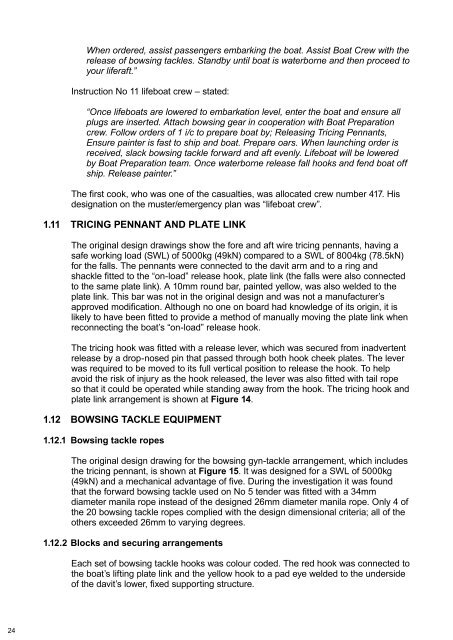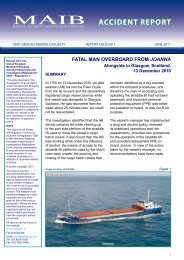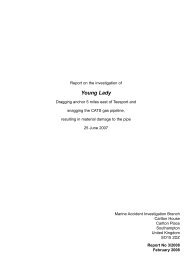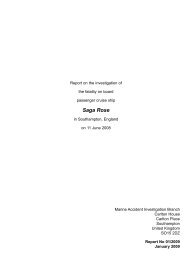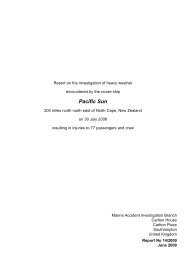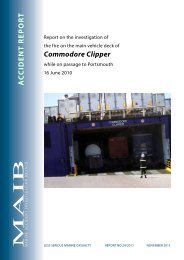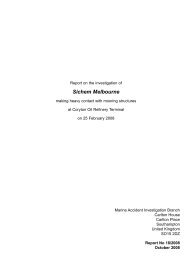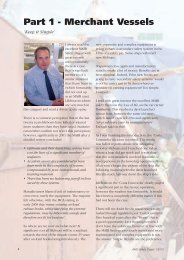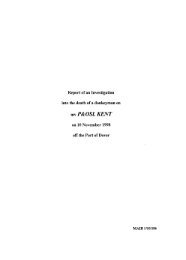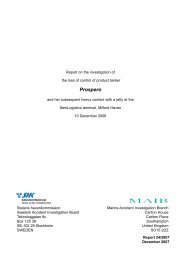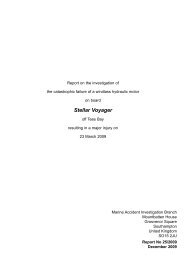SECTION 4 - Marine Accident Investigation Branch
SECTION 4 - Marine Accident Investigation Branch
SECTION 4 - Marine Accident Investigation Branch
Create successful ePaper yourself
Turn your PDF publications into a flip-book with our unique Google optimized e-Paper software.
24<br />
When ordered, assist passengers embarking the boat. Assist Boat Crew with the<br />
release of bowsing tackles. Standby until boat is waterborne and then proceed to<br />
your liferaft.”<br />
Instruction No 11 lifeboat crew – stated:<br />
“Once lifeboats are lowered to embarkation level, enter the boat and ensure all<br />
plugs are inserted. Attach bowsing gear in cooperation with Boat Preparation<br />
crew. Follow orders of 1 i/c to prepare boat by; Releasing Tricing Pennants,<br />
Ensure painter is fast to ship and boat. Prepare oars. When launching order is<br />
received, slack bowsing tackle forward and aft evenly. Lifeboat will be lowered<br />
by Boat Preparation team. Once waterborne release fall hooks and fend boat off<br />
ship. Release painter.”<br />
The first cook, who was one of the casualties, was allocated crew number 417. His<br />
designation on the muster/emergency plan was “lifeboat crew”.<br />
1.11 TRICING PENNANT AND PLATE LINk<br />
The original design drawings show the fore and aft wire tricing pennants, having a<br />
safe working load (SWL) of 5000kg (49kN) compared to a SWL of 8004kg (78.5kN)<br />
for the falls. The pennants were connected to the davit arm and to a ring and<br />
shackle fitted to the “on-load” release hook, plate link (the falls were also connected<br />
to the same plate link). A 10mm round bar, painted yellow, was also welded to the<br />
plate link. This bar was not in the original design and was not a manufacturer’s<br />
approved modification. Although no one on board had knowledge of its origin, it is<br />
likely to have been fitted to provide a method of manually moving the plate link when<br />
reconnecting the boat’s “on-load” release hook.<br />
The tricing hook was fitted with a release lever, which was secured from inadvertent<br />
release by a drop-nosed pin that passed through both hook cheek plates. The lever<br />
was required to be moved to its full vertical position to release the hook. To help<br />
avoid the risk of injury as the hook released, the lever was also fitted with tail rope<br />
so that it could be operated while standing away from the hook. The tricing hook and<br />
plate link arrangement is shown at Figure 14.<br />
1.12 BOwSING TACkLE EqUIPMENT<br />
1.12.1 Bowsing tackle ropes<br />
The original design drawing for the bowsing gyn-tackle arrangement, which includes<br />
the tricing pennant, is shown at Figure 15. It was designed for a SWL of 5000kg<br />
(49kN) and a mechanical advantage of five. During the investigation it was found<br />
that the forward bowsing tackle used on No 5 tender was fitted with a 34mm<br />
diameter manila rope instead of the designed 26mm diameter manila rope. Only 4 of<br />
the 20 bowsing tackle ropes complied with the design dimensional criteria; all of the<br />
others exceeded 26mm to varying degrees.<br />
1.12.2 Blocks and securing arrangements<br />
Each set of bowsing tackle hooks was colour coded. The red hook was connected to<br />
the boat’s lifting plate link and the yellow hook to a pad eye welded to the underside<br />
of the davit’s lower, fixed supporting structure.


